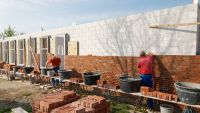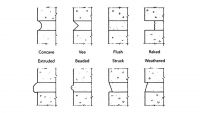Inspection of Masonry
A look at the requirements in the MSJC and the IBC
By Stuart Beavers, Phillip J. Samblanet
Inspection of masonry construction will be performed more frequently in the near future due to requirements in the 1999 MSJC (Masonry Standards Joint Committee) Building Code Requirements for Masonry Structures (ACI 530/ASCE 5/TMS 402) and Specification for Masonry Structures (ACI 530.1/ASCE 6/TMS 602), and the International Building Code (IBC). Whether you favor inspection or not, these documents require inspection of most new construction, and as they are adopted we will see more inspection on our projects. The need for inspection is increasing in every facet of building construction, as assurance that construction complies with the plans and specifications is being desired by owners, and especially by insurance industries and the federal government who so often have to pay for extensive repairs or replacements when buildings that are not constructed properly fail. More rigorous inspection is due in part because of the drastic difference in performance of well-constructed and poorly constructed buildings of all types. Investigators of buildings after natural disasters commonly report that a significant cause of damage is improper construction (Figures 1 and 2). Excessive damage due to such poor construction is unacceptable, and many believe that inspection will help produce higher quality construction, as it has in other industries.
The more favorable performance of properly constructed masonry versus substandard masonry construction has been graphically shown after numerous disasters. The photographs above show the dramatic difference in the performance of cantilever masonry type walls. Miles of the poorly constructed property walls collapsed after the Northridge, CA Earthquake, while relatively little damage was observed to taller highway sound barrier walls that were inspected during construction. While having an inspector on-site does not guarantee proper construction and favorable performance, experience in other industries clearly shows that the construction is more likely to conform to the plans and specifications if the work is inspected.
Three levels of quality assurance were developed based on the method of design and the importance of the structure. Structures that must maintain their function immediately after natural disasters (i.e. hospitals and fire stations) are classified as essential structures and must be inspected to a great degree (higher level). Methods of design and construction that are more typical in nature do not require as extensive an inspection program as methods employing more elaborate design and construction methods. Figure 3 shows a simplistic flow chart of how to determine the minimum level of inspection required based on the building's importance (essential or non-essential) and the design method. MSJC Code Tables 1.14.1.1, 1.14.1.2 and 1.14.1.3 show the minimum quality assurance requirements for each level.
The IBC separates testing and submittal requirements from the inspection requirements. Level 1, Level 2, and Level 3 testing and submittal requirements are provided in IBC Tables 1708.1.1, 1708.1.2, and 1708.1.4, respectively, and are not shown in this article since they are nearly identical to "Minimum Tests and Submittals" provisions (left column) of the MSJC tables. The inspection requirements are shown in IBC 1704.5, and here is where confusion can occur.
The IBC elected to drop the Level 1 inspection requirements from the MSJC because they were considered so minor. They therefore renumbered the remaining requirements, so that the Level 2 Inspection in the MSJC became the basis for the Level 1 IBC Inspection Requirements. Similarly, the Level 3 MSJC Inspection requirements became the basis for the Level 2 IBC Inspection requirements. Unfortunately, the different designations have created great confusion as to which Level 1 or 2 provisions are being required. There has been some consideration of redesignating the inspection levels to eliminate the confusion, but until that happens it is critically important to clearly state whether the inspection level is to conform to the MSJC requirements or the IBC requirements. And remember, the confusion is made worse, because by deleting the lowest level of inspection, a project complying with the IBC may require Leve2 Testing, but Level 1 Inspection.
While the Level 1 IBC requirements closely parallels Level 2 MSJC Requirements there are some important differences. The IBC has added some very useful reference criteria so that inspectors, contractors and engineers can quickly find out more about the items to be inspected. These references are quite handy, and we would hope that the MSJC consider similar modifications. Unfortunately it does appear that some references in the IBC tables are in error as they refer to the 1995 MSJC, not the 1999 MSJC. The authors have shown proposed revisions to the tables in strikeout/underline format. Readers are advised however, to review these references themselves to verify they are appropriate.
The IBC also added columns to describe the frequency of inspection to try to clarify the terms continuous and periodic inspection that have been used in many areas. Now it is very clear that continuous does not imply that the inspector must be on the job site every moment during the masonry construction process, but rather continuously during specific tasks, i.e. during the placement of the grout. By contrast, the inspector only needs to periodically observe many tasks such as the construction of mortar joints. Again, this is very helpful in defining the extent to which inspection must be provided, and it helps reduce the cost of inspection since the inspector often does not need to be on the jobsite fulltime.
The last major difference between the IBC Inspection Requirements and the MSJC Inspection Requirements occurs with the IBC requirement for inspection during the cold and hot weather construction.
Inspection helps ensure that masonry will be constructed properly and according to the plans and specifications. Such quality masonry will perform much better than poorly constructed masonry since the strength and durability of the masonry is mobilized. As designers and owners see this more favorable performance, their confidence in masonry, and hopefully their preference towards masonry, will grow.
Likewise portions of this article are reproduced from the 1999 edition of the Masonry Standards Joint Committee Building Code Requirements from Masonry Structures (ACI 530/ASCE 5/TMS 402), copyright( 1999, with the permission of The Masonry Society. The MSJC is a copyrighted work of the American Concrete Institute (ACI), the Structural Engineering Institute of the American Society of Civil Engineers (SEI/ASCE) and The Masonry Society (TMS). Although, The Masonry Society has granted permission for reproduction of these tables contained within the MSJC, TMS, ACI and SEI/ASCE assume no responsibility for the accuracy or the completion of summaries provided herein.
About the Authors
Stuart Beavers is a masonry consultant, and President of The Masonry Society. He chaired the MSJC Task Group on Masonry Inspection.
Phillip Samblanet is a professional engineer, and the Executive Director of The Masonry Society. He served as the secretary for the MSJC Inspection Task Group.


















